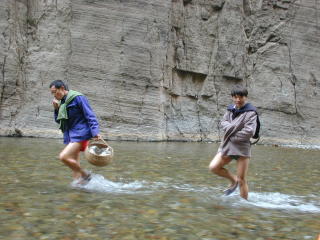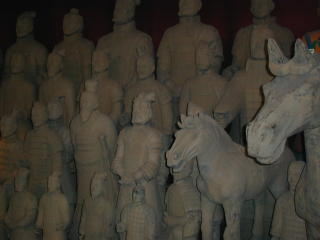Chongqing is located at the confluence of the Yangtzi and Jialing rivers. In the evening, we boarded the East Queen Cruise Ship waiting for us on the Yangtzi River. It is the most luxurious ship. Our cabins are on the 2nd floor with picture windows, TV, mini-bar, fluffy bathrobes and mini bathrooms. The top floor is a sun deck and there is a small health club with sauna/steam rooms, a bar/disco, restaurant, library, mahjong rooms, etc. Tomorrow morning we set off down the Yangtzi. It is the 3rd longest river in the world after the Amazon and the Nile.
The charm of the boat has worn off slightly. They were determined to let everyone know that we were setting sail at 6am by blasting the horn numerous times. Then we had absolutely the worst food we’ve been offered in the China. And to top it off, it is rainy season on the Yangtzi, we had a bit of drizzle and a gray misty day. Despite this, we had an interesting day. Charles Mason, the Asian art curator from the Allen Memorial Art Museum who is the “tour enrichment lecturer” gave us a lesson in Chinese calligraphy. We each got a brush, ink and paper and tried to write a few words. It’s a lot harder than it looks. The order of the strokes, the fat parts and thin tails of the strokes, how much ink to have on the brush and the many parts to each character are very difficult. As we were practicing many of the ship’s staff came by to watch us through the window. I suppose it looks a bit odd having an American teach Chinese calligraphy.

Later in the day, we stopped at the Stone Treasure Village. The most interesting thing about this village is that it will no longer exist when the dam is finished in 2009. The dam project is one of the most controversial in the world. The government insists that it is the solution to power shortages and flooding problems. The protesters say it will flood so much arable land, displace 1.4 million people, flood 1000s of historical sights and upset the animals and environmental balance. The Stone Treasure Village has a pagoda going up the mountain with a temple on the top built about 500AD. The bottom of the pagoda is below the future water line of 175 metres. They plan to build a wall around it and a bridge to access it. The new town has already been built higher on the hill. 50% of the people have already moved and the rest must move in the next 2 years. Each family must find their own new accommodation and if they want more space in the modern buildings, they must pay for it. All along the Yangtzi between Chongqing where we embarked and the dam, you see new ugly modern apartment blocks high up on the hill above where the water line will be.

This will create another problem which is increased water shortages. Already, there is a problem with water, but when everyone gets proper plumbing and starts flushing “Western” toilets and having showers, the problem will be exacerbated. Environmental issues are the biggest long term challenge that China has. 60% of the energy is produced by burning coal. Most families cook with coal, polluting both the environment and their lungs. Deforestation has resulted in decreased land productivity and much of the good quality soil being washed into the rivers. China has one of the most serious soil erosion problems in the world. China imports much of its food as the land cannot produce enough to feed everyone. The air is so polluted that trees are sometimes brown. Particle levels in northern cities are 10 times higher than in London. 407 micrograms per cubic metre vs. 48 in London – 90 is the maximum recommended particle level for safety by the WHO. In addition, they have an acid rain problem.

April 10, 2000
Today was the day we sailed through the 3 gorges. The first, Qutang Gorge, which was the shortest at 8km and most dramatic came at 6:30am. Then came the much longer Wu Gorge 1 hour later. As the ship goes through these narrow passageways, the wind is so strong, you can barely keep upright. The river swirls and dances with white caps breaking everywhere.

After breakfast, we were transferred to wooden Sampans, each taking about 10 people. We were to travel upstream on a tributary which flows into the Yangtzi called Shennong Stream. The Sampan was pulled upstream by 4 men called trackers. They wore shirts, colorful underpants and suit jackets. On their feet they had homemade sandals woven from bamboo leaves. I felt a bit guilty about them doing such hard manual labour, but it was only 1 km upstream and then they had a rest and floated downstream in the boat with us. Also the 4 trackers and the 2 guys in the boat who steered and poled (like punting) owned the boat themselves. Apparently they only work 3 days a week as boatmen but earn more money at this than they do from their other job which is farming. In the old days, trackers used to pull barges up the Yangtzi River. There are paths cut into the gorges for them. That must have been a terrible job to pull a boat upstream at the gorges where the water flows so fast. The boat trip took us upstream through beautiful gorges. The water level was very low and several industrious vendors waded through the water following us to try and sell various souvenirs. Coming back, it was silent except for a few birds and the sound of rushing water. This was one of the highlights of the whole trip.

In the afternoon, we arrived at the 3rd gorge. This is where the new dam is being constructed. It is the largest construction site in the world. It will consist of 5 locks for ships each taking 30 minutes to go through, a “ship elevator” for small ships, the main dam with 2 power generation plants and a middle section to let the water pass and to deal with the silt. The men working on the site look like little ants compared to the size of the project. The base of the dam will be 100 metres or 5 football fields wide. This is what will hold back the full weight of the water. They have built viewing towers and nice landscaped areas from which to view the project. You could almost imagine it was a James Bond movie set.
Along the river, we also passed a number of hillside cemeteries. Now, the government requires that everyone be cremated. This is very upsetting for the Buddhists as they believe the soul needs somewhere to reside and it the body is burned, the soul will have nowhere to go.

![]()

























